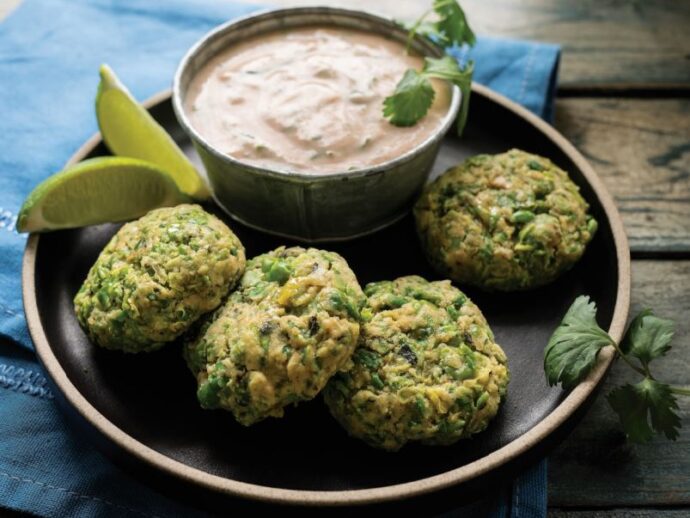
These satisfying two-bite snacks are perfect any time of day. Feel free to serve them with your favorite dipping sauce. (But hey: The coconut-lime one here is a winner. Just sayin’!). Green peas are one hardworking legume. They’re loaded with vitamins, high in fiber, and a good source of protein.
Ingredients
Poppers
1 Tbsp grapeseed oil, plus extra for baking
1 Vidalia (sweet) onion, diced
3 garlic cloves, minced
2 cups frozen peas, thawed
1 1/2 cups chickpea flour
1 tsp baking soda
1/4 tsp sea salt
1 tsp ground cumin
2 Tbsp minced fresh mint or 2 tsp dried mint
Coconut-lime dipping sauce
1/2 cup unsweetened coconut yogurt
2 Tbsp coconut cream
1 tsp finely grated lime zest
1 tsp lime juice
1 Tbsp finely chopped fresh cilantro
1/4 tsp smoked paprika
1/4 tsp cayenne pepper
Directions
Make the poppers: Preheat oven to 350 F. Line baking tray with parchment paper and set aside.
In large frying pan over medium heat, warm oil. Add onion and cook until softened and translucent, about 8 minutes. Stir in garlic and cook for another minute.
Transfer cooked onion and garlic mixture to food processor. Add peas and pulse until mixture becomes a thick paste that still has texture to it. Transfer to large bowl along with chickpea flour, baking soda, salt, cumin, and mint. Stir with wooden spoon until well combined.
With wet hands, take 1 Tbsp pea mixture. Roll mixture into a ball and place on prepared baking tray. Press down slightly to form a round patty. Repeat with remaining pea mixture. Brush poppers lightly with some extra oil before baking in oven for 10 minutes. Flip poppers over and bake once more until golden brown, about another 8 to 10 minutes.
Make the dipping sauce: Whisk all coconut-lime dipping sauce ingredients together in bowl until well combined.
Serve warm poppers with dipping sauce. Leftover poppers may be cooled to room temperature and stored in airtight container in refrigerator for up to 3 days.
Tip: Make Green Pea Poppers more of a meal by adding them to a salad or using them as a filling in a pita sandwich.
Protein primer
Here are some basic rules to keep in mind when planning your next high-protein vegan meal.
Consider the whole package
When choosing a vegan protein to incorporate into your meal, ensure you consider the total package. What types of fats, carbs, vitamins, and minerals come along with the protein? Aim for protein sources that are low in saturated fats and processed carbohydrates and high in beneficial vitamins and minerals.
Focus on variety
Proteins are formed from chains of amino acids. For the most part, plants don’t contain complete proteins (aka adequate amounts of all the essential amino acids). To ensure you’re getting a range of amino acids to make up a complete protein, pair grains and legumes together, or nuts and seeds with legumes. These pairings are referred to as “complementary proteins” because together, they give you a full complement of essential amino acids. You don’t need to eat complementary proteins at every meal. As long as you enjoy a wide variety of whole foods, you should be getting ample amounts of protein and other key nutrients throughout the day.
Pack protein snacks
Try to always incorporate a protein-packed item into your daily snacks. In a pinch, a handful of nuts provides a good source of healthy fats and protein that will help fuel you through to your next meal.
Journal your protein intake
If you’re concerned that you’re not hitting your target protein consumption, try keeping a food journal. Taking stock of everything you eat over the course of a week can really help illustrate where you’re meeting your goals and where you’re falling short.
In each delicious serving: 277 calories / 12 g protein / 10 g fat / 36 g carbs (9 g sugar, 8 g fiber) / 403 mg

